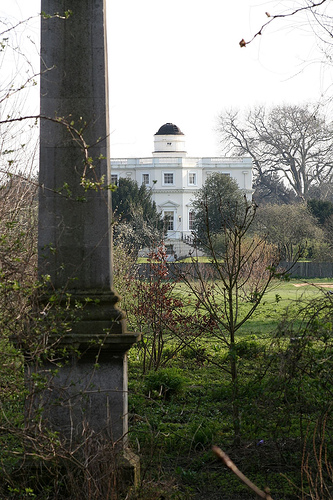
Kew Observatory
Encyclopedia

Observatory
An observatory is a location used for observing terrestrial or celestial events. Astronomy, climatology/meteorology, geology, oceanography and volcanology are examples of disciplines for which observatories have been constructed...
founded by King George III (1760-1820), located within the Old Deer Park
Old Deer Park
Old Deer Park is an area of open space within Richmond-upon-Thames, England, and is in extent. The park is bounded generally by the River Thames to the west, Kew Gardens to the north, and urban areas of Richmond town to the east and south. Owned by the Crown Estate, the park forms part of a larger...
of the former Richmond Palace
Richmond Palace
Richmond Palace was a Thameside royal residence on the right bank of the river, upstream of the Palace of Westminster, to which it lay 9 miles SW of as the crow flies. It it was erected c. 1501 within the royal manor of Sheen, by Henry VII of England, formerly known by his title Earl of Richmond,...
in Richmond, Surrey, now within Greater London. The former royal manor of Kew
Kew
Kew is a place in the London Borough of Richmond upon Thames in South West London. Kew is best known for being the location of the Royal Botanic Gardens, now a World Heritage Site, which includes Kew Palace...
lies to the immediate north. The Observatory grounds overlie to the south the site of the former Carthusian Sheen Priory
Sheen Priory
Sheen Priory in Sheen, now Richmond, London was a former Carthusian monastery founded in 1414 within the royal manor of Sheen, on the south bank of the Thames, upstream and approximately 9 miles southwest of the Palace of Westminster...
established by King Henry V in 1414.
In the past, the Kew Observatory participated in assessing and rating Swiss timepiece movements for accuracy. As marine navigation adopted the usage of mechanical timepieces for navigational aid, the accuracy of such timepieces became more critical. From this need developed an accuracy testing regime involving various astronomical observatories. In Europe
Europe
Europe is, by convention, one of the world's seven continents. Comprising the westernmost peninsula of Eurasia, Europe is generally 'divided' from Asia to its east by the watershed divides of the Ural and Caucasus Mountains, the Ural River, the Caspian and Black Seas, and the waterways connecting...
, the Neuchatel Observatory
Neuchâtel Observatory
The Observatoire Cantonal de Neuchâtel is an astronomical observatory funded by the Public Economy Department of the Neuchâtel State . It is located in Neuchâtel and was founded in 1858. Besides astronomical observations, the Neuchâtel observatory also works with atomic clocks...
, Geneva Observatory Besancon Observatory and Kew Observatory were examples of prominent observatories that tested timepiece movements for accuracy. The testing process lasted for many days, typically 45 days. Each movement was tested in 5 positions and 2 temperatures, in 10 series of 4 or 5 days each. The tolerances for error were much finer than any other standard, including the modern COSC
COSC
COSC aka C.O.S.C. is Contrôle Officiel Suisse des Chronomètres, the Official Swiss Chronometer Testing Institute, which is the institute responsible for certifying the accuracy and precision of wristwatches in Switzerland.-Background:...
standard. Movements that passed the stringent tests were issued a certification from the observatory called a Bulletin de Marche, signed by the Directeur of the Observatory. The Bulletin de Marche stated the testing criteria, and the actual performance of the movement. A movement with a Bulletin de Marche from an observatory became known as an Observatory Chronometer
Observatory Chronometer
In the world of mechanical timepieces, accuracy is paramount. In the times before electronics, mechanical timepieces called marine chronometers were developed to a very high degree of accuracy and used for maritime navigation...
, and such were issued a chronometer reference number by the Observatory.
The role of the observatories in assessing the accuracy of mechanical timepieces was instrumental in driving the mechanical watchmaking industry toward higher and higher levels of accuracy. As a result, today high quality mechanical watch movements have an extremely high degree of accuracy. However, no mechanical movement could ultimately compare to the accuracy of the quartz movements being developed. Accordingly, such chronometer certification ceased in the late 1960s and early 1970s with the advent of the quartz watch movement.
Directors (Superintendents) of the observatory included Stephen Demainbray
Stephen Demainbray
Stephen Charles Triboudet Demainbray, Esq. of Richmond was an English natural scientist and astronomer, who served during 1768-1782 as Superintendent of the King's Observatory at the Kew Observatory....
, John Welsh, Balfour Stewart
Balfour Stewart
Balfour Stewart was a Scottish physicist. His studies in the field of radiant heat led to him receiving the Rumford Medal of the Royal Society in 1868. In 1859 he was appointed director of Kew Observatory...
, G. M. Whipple, Francis John Welsh Whipple
Francis John Welsh Whipple
Francis John Welsh Whipple was a British mathematician and meteorologist. From 1925 to 1939 he was superintendent of the Kew Observatory.-Biography:...
, Charles Chree
Charles Chree
Charles Chree was a British physicist.He was born in Lintrathen, Forfarshire, Scotland and educated at the Grammar School, Old Aberdeen, the University of Aberdeen where he graduated MA in 1879 and the University of Cambridge...
, and George Clarke Simpson.

